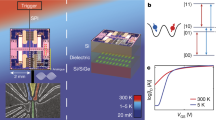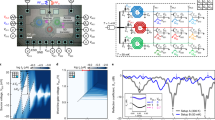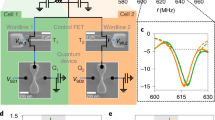Abstract
Scaled-up quantum computers will require control interfaces capable of the manipulation and readout of large numbers of qubits, which usually operate at millikelvin temperatures. Advanced complementary metal–oxide–semiconductor (CMOS) technology is an attractive platform for delivering such interfaces. However, this approach is generally discounted due to its high power dissipation, which can lead to the heating of fragile qubits. Here we report a CMOS-based platform that can provide multiple electrical signals for the control of qubits at 100 mK. We demonstrate a chip that is configured by digital input signals at room temperature and uses on-chip circuit cells that are based on switched capacitors to generate static and dynamic voltages for the parallel control of qubits. We use our CMOS chip to bias a quantum dot device and to switch the conductance of a quantum dot via voltage pulses generated on the chip. Based on measurements from six cells, we determine the average power dissipation for generating control pulses of 100 mV to be 18 nW per cell. We estimate that a scaled-up system containing a thousand cells could be cooled by a commercially available dilution refrigerator.
This is a preview of subscription content, access via your institution
Access options
Access Nature and 54 other Nature Portfolio journals
Get Nature+, our best-value online-access subscription
$29.99 / 30 days
cancel any time
Subscribe to this journal
Receive 12 digital issues and online access to articles
$119.00 per year
only $9.92 per issue
Buy this article
- Purchase on Springer Link
- Instant access to full article PDF
Prices may be subject to local taxes which are calculated during checkout




Similar content being viewed by others
Data availability
The datasets generated and/or analysed during the current study are available from the corresponding author upon reasonable request.
References
Reiher, M., Wiebe, N., Svore, K. M., Wecker, D. & Troyer, M. Elucidating reaction mechanisms on quantum computers. Proc. Natl Acad. Sci. USA 114, 7555–7560 (2017).
Preskill, J. Quantum computing in the NISQ era and beyond. Quantum 2, 79 (2018).
Somma, R. D., Boixo, S., Barnum, H. & Knill, E. Quantum simulations of classical annealing processes. Phys. Rev. Lett. 101, 130504 (2008).
Bravyi, S., Gosset, D. & König, R. Quantum advantage with shallow circuits. Science 362, 308–311 (2018).
Aspuru-Guzik, A., Dutoi, A. D., Love, P. J. & Head-Gordon, M. Simulated quantum computation of molecular energies. Science 309, 1704–1707 (2005).
Das, K. & Lehmann, T. Low power fast cryogenic CMOS circuit for digital readout of single electron transistor. In Proc. Midwest Symposium on Circuits and Systems 1–4 (IEEE, 2011).
Reilly, D. J. Engineering the quantum-classical interface of solid-state qubits. npj Quantum Inf. 1, 15011 (2015).
Hornibrook, J. M. et al. Cryogenic control architecture for large-scale quantum computing. Phys. Rev. Applied 3, 024010 (2015).
Vandersypen, L. M. K. et al. Interfacing spin qubits in quantum dots and donors—hot, dense, and coherent. npj Quantum Inf. 3, 34 (2017).
McDermott, R. et al. Quantum–classical interface based on single flux quantum digital logic. Quantum Sci. Technol. 3, 024004 (2018).
Bardin, J. C. et al. 29.1 A 28nm bulk-CMOS 4-to-8GHz <2mW cryogenic pulse modulator for scalable quantum computing. In 2019 IEEE International Solid-State Circuits Conference 456–458 (IEEE, 2019).
Geck, L., Kruth, A., Bluhm, H., van Waasen, S. & Heinen, S. Control electronics for semiconductor spin qubits. Quantum Sci. Technol. 5, 015004 (2019).
Patra, B. et al. Cryo-CMOS circuits and systems for quantum computing applications. IEEE J. Solid-State Circuits 53, 309–321 (2018).
Patra, B. et al. A scalable cryo-CMOS 2-to-20GHz digitally intensive controller for 4 × 32 frequency multiplexed spin qubits/transmons in 22nm FinFET technology for quantum computers. In 2020 IEEE International Solid-State Circuits Conference 304–306 (IEEE, 2020).
Landman, B. S. & Russo, R. L. On a pin versus block relationship for partitions of logic graphs. IEEE Trans. Comput. C-20, 1469–1479 (1971).
Reilly, D. J. Challenges in scaling-up the control interface of a quantum computer. In 2019 IEEE International Electron Devices Meeting 31.7.1–31.7.6 (IEEE, 2019).
Wootters, W. K. & Zurek, W. H. A single quantum cannot be cloned. Nature 299, 802–803 (1982).
Franke, D., Clarke, J., Vandersypen, L. & Veldhorst, M. Rent’s rule and extensibility in quantum computing. Microprocess. Microsy. 67, 1–7 (2019).
Krinner, S. et al. Engineering cryogenic setups for 100-qubit scale superconducting circuit systems. EPJ Quantum Technol. 6, 2 (2019).
Arute, F. et al. Quantum supremacy using a programmable superconducting processor. Nature 574, 505–510 (2019).
Veldhorst, M., Eenink, H. G. J., Yang, C. H. & Dzurak, A. S. Silicon CMOS architecture for a spin-based quantum computer. Nat. Commun. 8, 1766 (2017).
Bai, Y. et al. Manufacturability and performance of 2.3-μm HgCdTe H2RG sensor chip assemblies for Euclid. In Proc. SPIE 10709, High Energy, Optical, and Infrared Detectors for Astronomy VIII 1070915 (SPIE, 2018).
Karzig, T. et al. Scalable designs for quasiparticle-poisoning-protected topological quantum computation with Majorana zero modes. Phys. Rev. B 95, 235305 (2017).
Petta, J. R. et al. Coherent manipulation of coupled electron spins in semiconductor quantum dots. Science 309, 2180–2184 (2005).
Casparis, L. et al. Superconducting gatemon qubit based on a proximitized two-dimensional electron gas. Nat. Nanotechnol. 13, 915–919 (2018).
Croot, X. et al. Device architecture for coupling spin qubits via an intermediate quantum state. Phys. Rev. Applied 10, 044058 (2018).
Hornibrook, J. M. et al. Frequency multiplexing for readout of spin qubits. App. Phys. Lett. 104, 103108 (2014).
Das, K. & Lehmann, T. Effect of deep cryogenic temperature on silicon-on-insulator CMOS mismatch: a circuit designer’s perspective. Cryogenics 62, 84–93 (2014).
Beckers, A. et al. Characterization and modeling of 28-nm FDSOI CMOS technology down to cryogenic temperatures. Solid State Electron. 159, 106–115 (2019).
Yang, Y., Das, K., Moini, A. & Reilly, D. J. A cryo-CMOS voltage reference in 28-nm FDSOI. IEEE Solid-State Circuits Lett. 3, 186–189 (2020).
Reilly, D. J., Marcus, C. M., Hanson, M. P. & Gossard, A. C. Fast single-charge sensing with a rf quantum point contact. App. Phys. Lett. 91, 162101 (2007).
Fallahi, S., Nakamura, J. R., Gardner, G. C., Yannell, M. M. & Manfra, M. J. Impact of silicon doping on low-frequency charge noise and conductance drift in GaAs/AlxGa1−xAs nanostructures. Phys. Rev. Applied 9, 034008 (2018).
Acknowledgements
This research was supported by Microsoft Corporation and the Australian Research Council Centre of Excellence for Engineered Quantum Systems (EQUS, CE170100009). We thank R. Rouse for help with the chip tape out and M. Cassidy, S. Waddy, C. Marcus and L. Kouwenhoven for discussions. We acknowledge the facilities as well as the scientific and technical assistance of the Research and Prototype Foundry, a Core Research Facility at the University of Sydney, and a part of the Australian National Fabrication Facility (ANFF).
Author information
Authors and Affiliations
Contributions
S.J.P., K.D., A.M. and D.J.R. conceived the presented idea. K.D., A.M., Y.Y. and C.C. designed the CMOS chip and packaging. K.D., A.M., M.T., A.B. and N.D. performed the characterization experiments on the CMOS chip. The GaAs heterostructure was grown by G.C.G. and M.J.M., and the QD device was fabricated by S.J.P. S.J.P., K.D. and R.K. performed the experiment interfacing the CMOS chip to the GaAs QD device. S.J.P., K.D. and D.J.R. wrote the manuscript with input from all the authors.
Corresponding author
Ethics declarations
Competing interests
The authors declare no competing interests.
Additional information
Publisher’s note Springer Nature remains neutral with regard to jurisdictional claims in published maps and institutional affiliations.
Extended data
Extended Data Fig. 1 Calibration procedure for gate leakage measurements.
a, Quantum dot device used to extract gate leakage. Gates used are highlighted in red, and the current path used for the measurement is shown by the green arrow. b, Sample calibration trace, taken by sweeping the voltage on the LW gate, while the charge lock switch GHOLD is closed. The extraction process for gate voltage is indicated by arrows. c, The measured current through the QPC when the charge locking switch is opened. d, The extracted gate voltage held on the gate for a period of 30 minutes.
Extended Data Fig. 2 Extracted charge leakage as VHOLD is varied, prior to removal of charge noise.
a-g, Traces from which charge leakage is extracted in Fig. 3c, as VHOLD is varied, and prior to removal of charge noise. The large steps in the extracted gate voltage are caused by low frequency charge noise in the donor layer.
Extended Data Fig. 3 Extracted charge leakage as VHOLD is varied, after removal of charge noise.
a-g, Traces from which charge leakage is extracted in Fig. 3c as VHOLD is varied, following the removal of charge noise. Each trace is fit with a line, from which the leakage rate is extracted.
Supplementary information
Supplementary Information
Supplementary Figs. 1–4 and detailed discussion on the design of various blocks of the CMOS circuit.
Rights and permissions
About this article
Cite this article
Pauka, S.J., Das, K., Kalra, R. et al. A cryogenic CMOS chip for generating control signals for multiple qubits. Nat Electron 4, 64–70 (2021). https://doi.org/10.1038/s41928-020-00528-y
Received:
Accepted:
Published:
Issue Date:
DOI: https://doi.org/10.1038/s41928-020-00528-y
This article is cited by
-
Non-symmetric Pauli spin blockade in a silicon double quantum dot
npj Quantum Information (2024)
-
Multiplexed superconducting qubit control at millikelvin temperatures with a low-power cryo-CMOS multiplexer
Nature Electronics (2023)
-
Extremely large area (88 mm × 88 mm) superconducting integrated circuit (ELASIC)
Scientific Reports (2023)
-
Compilation and scaling strategies for a silicon quantum processor with sparse two-dimensional connectivity
npj Quantum Information (2023)
-
Noisy intermediate-scale quantum computers
Frontiers of Physics (2023)



